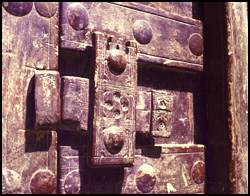ViewZone Expedition 2001
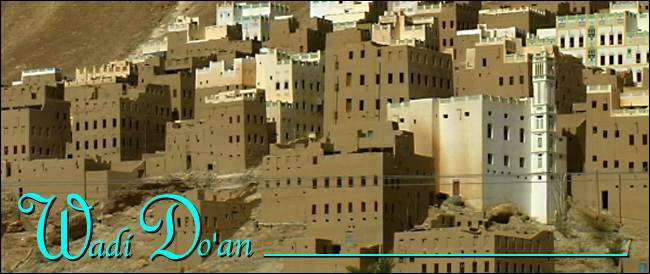
|
Wadi Do'an is a tributary of Wadi Hadrhamout. A large pastel-tinted canyon, it carried our crew along a single vein of highway that was flanked by steep cliff walls. The wadi itself contained mostly rounded rocks and pebbles, a reminder that it annually carried a torrent of rain water. Though the environment was extreme, trees and specially adapted shrubs studded the desert.
"Ma?" Nasser asked, " Water?" He was off to the kiosk to gather supplies for the day's drive.
"Aywah," I nodded. "Shoo-kran, Thank you." It did not take long to appreciate how essential water was to functioning in this arid environment. We stocked up daily on bottled water and we would often stop along the way to replenish our supply and stretch our legs. Bottled water was everywhere and it was inexpensive -- about 3 liters for a dollar. Drinking tap water was something we all avoided but we were all exposed to it when we washed, brushed our teeth or drank shai. None of our crew ever got sick during the entire journey in Yemen.
|

|
A delicate tomb in Al Mah-jad, this monument is said to have been the only known Sufi tomb in Yemen [see top left]. It sits awash in sunlight, at the base of a cliff near the mouth of the canyon. We visited the cemetery, careful to remove our shoes as a sign of respect, and remembered the Sufi, an Islamic sect that worships Allah through dancing and meditation. This form of Islam is very popular in many Middle-East countries, but not in Yemen.
Honey Valley
Wadi Do'an had its unique style of dress. I went for a stroll along the wadi floor and met a shepherdess [see left] with her flock. Wearing the traditional pointed, tall straw hats that are used to balance sheaves of grass, the young woman was busy knocking the branches of young trees with a long stick, dislodging the dry leaves. Her actions attracted the small herd of black and white sheep who quickly ate them as soon as they fell on the ground.
Al Hossa, was a remote village that could only be reached by the stream -- and only during the dry seasons. Despite its remoteness, cozy homes hung from the cliffs [left] on the western side of the canyon. The village seemed empty but I was told that most of the inhabitants were resting and "keeping cool" in the top floors of their homes.
|
I don't remember when I was ever hotter. My digital thermometer topped out at one hundred and ten degrees. The handle on my hair brush softened until I could easily bend it! But the heat was tolerable with some shade, shai and friendly company.
Reaching Sif we rested for the night at the charming Ribbon Hotel.
Our day had been a shimmering one, full of honey and shepherdesses, the zoomorph of the Elephant Mountain and river-bed roads. After a delicious meal on the hotel's modest patio, we climbed the stairs up to the roof to enjoy a slight breeze.
Star-gazing from the rooftop, we listened to the evening call to prayer from a distant mosque, followed by nighttime sounds from the fields and the streets of Sif. Tawny bats winged by, occasionally highlighted in the yellow street lamps. A mother dog and her pup trolled the street for dinner. The murmur of men, speaking quietly on the sidewalk below, faded into silence. Good-night, Yemen...
The morning sun found us speeding across the flat lands of the plateau -- destination: Al Mulkulla.
|
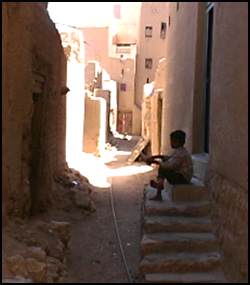
|
Previous Page || ViewZone || --next-->
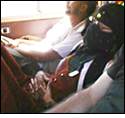 Our crew left the BMC Hotel early in the cooler hours of morning in order to more comfortably cover kilometers of travel needed to reach this historic valley. Wadi Do'an was once a trail leading to the main frankincense route from the more distant towns. Now it was a tranquil valley, decorated with quaint villages and lush oasis of palm trees.
Our crew left the BMC Hotel early in the cooler hours of morning in order to more comfortably cover kilometers of travel needed to reach this historic valley. Wadi Do'an was once a trail leading to the main frankincense route from the more distant towns. Now it was a tranquil valley, decorated with quaint villages and lush oasis of palm trees. 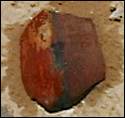 Leaving Al Mah-jad, we drove along the Wadi to Raybon. Raybon was now just dunes and gullies, but it was once a thriving city with an industry based around the wine trade. Even today, ancient pottery shards and obsidian flakes can be found like candy from a pinyata [pictured right], scattered along the old trade routes leading to the port city of Al Mulkulla. I managed to find several large pieces of old pottery in the sand, exposed by the wind.
Leaving Al Mah-jad, we drove along the Wadi to Raybon. Raybon was now just dunes and gullies, but it was once a thriving city with an industry based around the wine trade. Even today, ancient pottery shards and obsidian flakes can be found like candy from a pinyata [pictured right], scattered along the old trade routes leading to the port city of Al Mulkulla. I managed to find several large pieces of old pottery in the sand, exposed by the wind. 